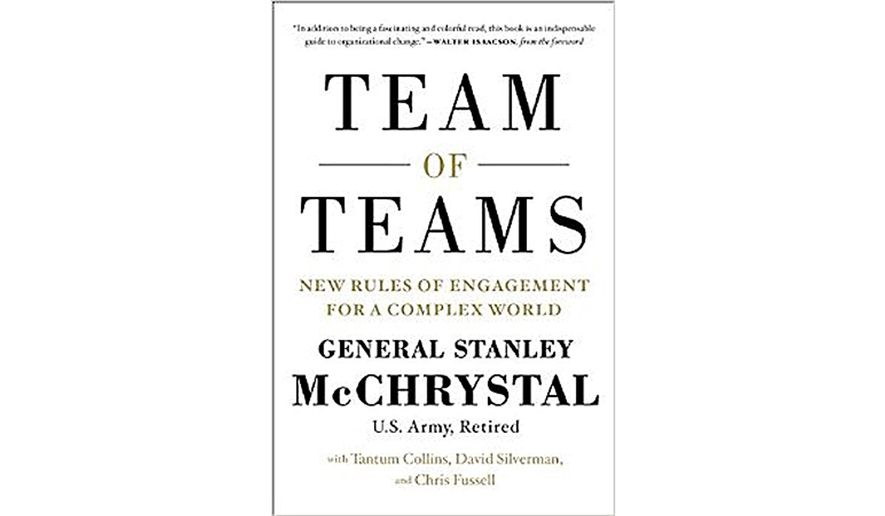OPINION:
TEAM OF TEAMS: NEW RULES OF ENGAGEMENT FOR A COMPLEX WORLD
By Gen. Stanley McChrystal
Portfolio, $29.95, 304 pages
Gen. Stanley McChrystal’s latest book, “Team of Teams,” is required reading for anyone aspiring to 21st century leadership.
Gen. McChrystal is hardly the first author to suggest that business executives could apply wartime lessons to their board rooms. (My 2004 book on that subject vanished without a trace.) But even then, Stan McChrystal was beginning to adapt American special forces in Iraq to a new kind of warfare, confronting a protean, aggressive enemy perfectly adapted to the subtleties of a shifting, complex environment.
His book begins with an arresting example: “Five muscled silhouettes, midnight blue against the sand-colored sunrise, moved down an otherwise empty street” in a Baghdad suburb. Only gradually does the reader realize that these superbly trained operators — flowing toward their goal as smoothly as an NBA team — are not American Rangers but al Qaeda (AQI) insurgents. Their September 2004 attack with three suicide vehicles killed 35 children and wounded 150 others. “For al Qaeda in Iraq the operation was a success.”
Almost as shocking: “We had a large, well-trained, superbly equipped force, while AQI had to recruit locals and smuggle in foreign fighters .[So] why were we unable to defeat an under-resourced insurgency? Why were we losing?” The drearily recurring culprit: American bureaucratic reductionism, sanctified in managerial thought and practice, honed throughout the military-industrial complex and wired together in a top-down hierarchy of electronic stovepipes and information silos.
As sacraments of 20th century warfare, reductionism and hierarchical obeisance were enshrined and reinforced from service academies through the higher military staff colleges. In contrast, “AQI was an organization native to the information-rich, densely interconnected world of the 21st century . In the course of this fight, we had to un-learn a great deal of what we thought we knew about how war — and the world — worked.” The systemic solution: restructuring, seamlessly sharing information while dissolving hierarchical walls, “a team of teams” linked by “shared consciousness” and “empowered execution.” These were not just empty slogans: “Almost everything we did ran against the grain of military tradition and general organizational practice. We abandoned many of the precepts that had helped establish our efficacy in the twentieth century, because the twenty-first century is a different game with different rules.”
“Team of Teams” is a compelling read, with well-documented sources and a remarkably fluid writing style, carefully scrubbed of Pentagon acronyms, overstatements and psychobabble. One routinely encounters great commanders like Lord Nelson at Trafalgar — inspiring his captains to create deliberate chaos in a French fleet built around orderly, centralized control. But these familiar stories take on new meanings in the chaotic 21st century world of commercial competition. The parallels are constant: “We had more in common with the plight of a Fortune 500 company trying to fight off a swarm of start-ups than we did with battling Nazi Germany in World War II.”
Gen. McChrystal’s book also makes a major intellectual contribution by linking his recent experiences as a combat commander to the larger progression of managerial thought: from F.W. Taylor and Henri Fayol to Alfred D. Chandler, and from the top-down scions of General Motors to Alan Mullaly’s last-ditch fight to save Ford Motors. In deciding to “forcibly dismantle the old system and replace it with an entirely new managerial structure,” the Team of Teams deliberately harnessed the “collective intelligence” of bands of brothers long limited by institutional boundaries and the “need to know.”
But the real benchmark of Stanley McChrystal’s genius as a commander was his rigorous suppression of ego while serving his soldiers and subordinates. Although you should probably not try this at home, Gen. McChrystal was, like Lord Nelson, “working to pump general-officer information and awareness throughout our ranks . In the old model, subordinates provided information and leaders disseminated commands. We reversed it: we had our leaders provide information so that subordinates could take the initiative and make decisions.”
Little things had their usual disproportionate impact, like recognizing junior briefing officers by their first names. “Thank you became my most important phrase, interest and enthusiasm my most powerful behaviors.” The overall effect of this “Eyes On, Hands Off” procedure: the refinement of an organization that now functioned 17 times more effectively than before — and utterly destroyed our most lethal adversaries.
So here’s a final thought: To help reduce corporate complacency, why not send this book along to your favorite board of directors? Maybe it could also provoke some interesting and overdue questions at their next stockholder’s convention.
• Ken Allard, a retired Army colonel, is a military analyst and author on national-security issues.




Please read our comment policy before commenting.